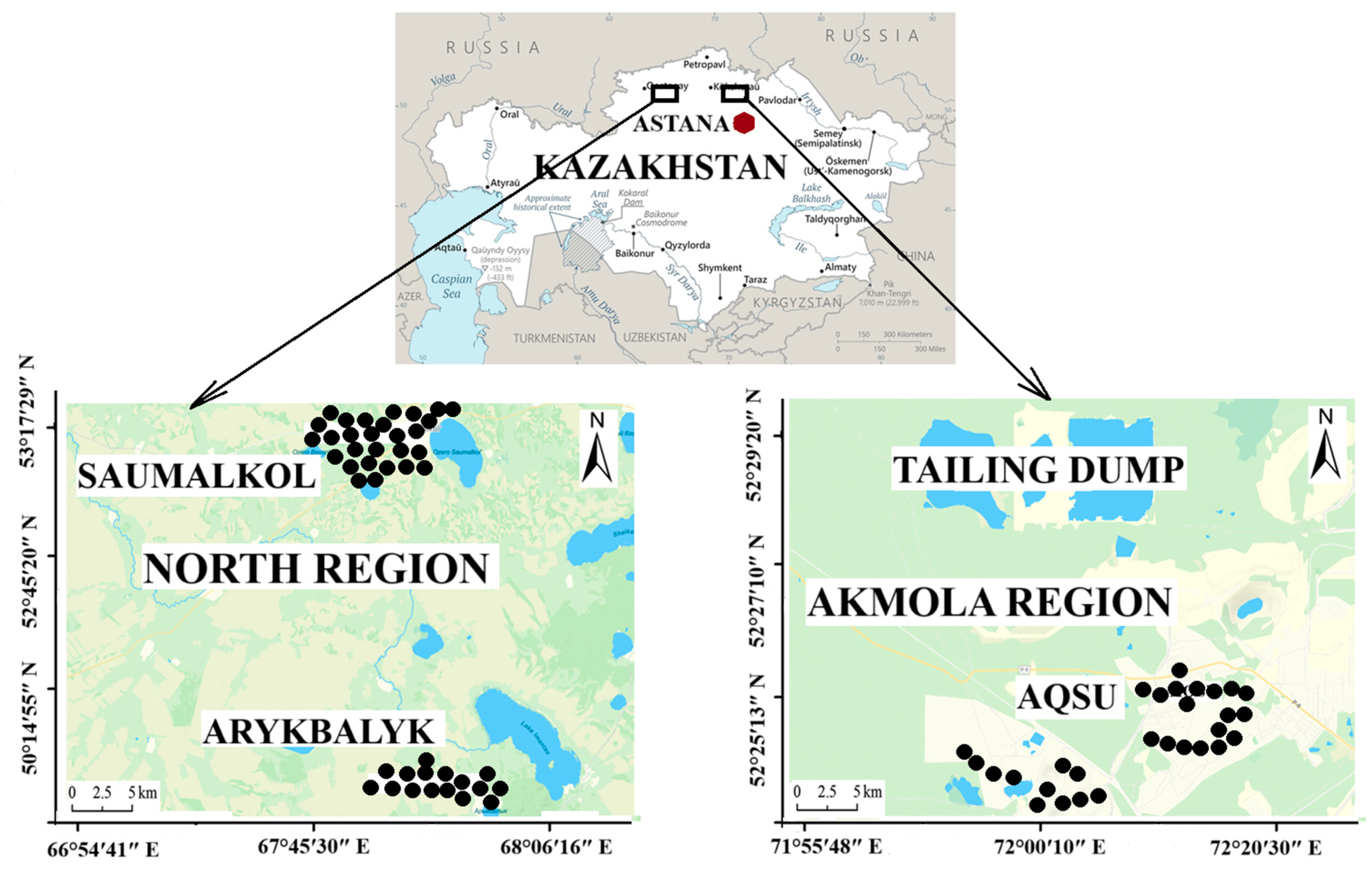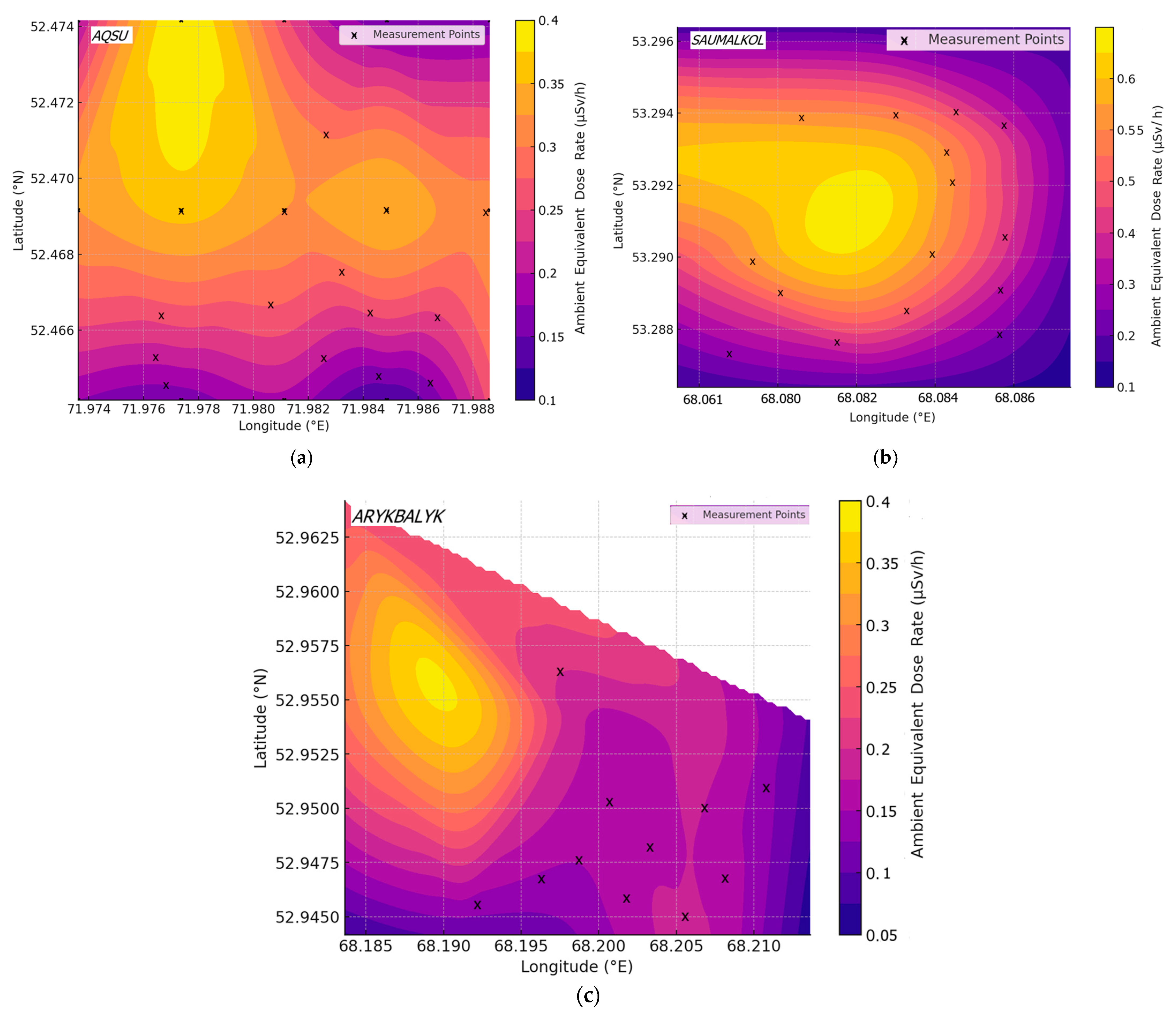Radon Concentration Survey in Settlements Located in Uranium Mining Territory in Northern Kazakhstan
Abstract
1. Introduction
2. Materials and Methods
2.1. Study Area
2.2. Measurement of Ambient Equivalent Dose Rates
2.3. Radon Concentration Measurement
2.4. Statistical Analysis
3. Results
3.1. Gamma Radiation
Indoor Radon Estimation
4. Discussion
5. Conclusions
Author Contributions
Funding
Institutional Review Board Statement
Informed Consent Statement
Data Availability Statement
Conflicts of Interest
References
- ICRP, 65. International Commission on Radiological Protection. Protection Against Radon-222 at Home and at Work; Pergamon Press: Oxford, UK, 1993. [Google Scholar]
- World Health Organization. WHO Handbook on Indoor Radon: A Public Health Perspective; World Health Organization: Geneva, Switzerland, 2009. [Google Scholar]
- UNSCEAR Source and Effect of Ionizing Radiation. The General Assembly with Scientific Annex; Annex B: Exposure of the Public and Workers from Various Sources of Radiation; UNSCEAR, United Nations: New York, NY, USA, 2010. [Google Scholar]
- Al-Zoughool, M.; Krewski, D. Health Effects of Radon: A Review of the Literature. Int. J. Radiat. Biol. 2009, 85, 57–69. [Google Scholar] [CrossRef] [PubMed]
- US Environmental Protection Agency. A Citizen’s Guide to Radon; US Environmental Protection Agency: Washington, DC, USA, 2007.
- Caridi, F.; Paladini, G.; Gregorio, F.; Lanza, S.; Lando, G.; Sfacteria, M.; Tuccinardi, S.; Venuti, M.; Cardiano, P.; Majolino, D.; et al. Natural Radioactivity Content and Radon Exhalation Rate Assessment for Building Materials from the Archaeological Park of Tindari, Sicily, Southern Italy: A Case Study. Int. J. Environ. Res. Public Health 2025, 22, 379. [Google Scholar] [CrossRef]
- ICRP (International Commission on Radiological Protection). Radiological Protection Against Radon Exposure; SAGE Publication: London, UK, 2014. [Google Scholar]
- Moshupya, P.M.; Mohuba, S.C.; Abiye, T.A.; Korir, I. Evaluation of Indoor Radon Activity Concentrations and Controls in Dwellings Surrounding the Gold Mine Tailings in Gauteng Province of South Africa. Int. J. Environ. Res. Public Health 2023, 20, 7010. [Google Scholar] [CrossRef] [PubMed]
- Aghdam, M.M.; Crowley, Q.; Rocha, C.; Dentoni, V.; Da Pelo, S.; Long, S.; Savatier, M. A study of natural radioactivity levels and radon/thoron release potential of bedrock and soil in southeastern Ireland. Int. J. Environ. Res. Public Health 2021, 18, 2709. [Google Scholar] [CrossRef]
- Boystov, A. Worldwide ISL Uranium Mining Outlook; URAM; IAEA: Vienna, Austria, 2014. [Google Scholar]
- IAEA. In Situ Leach Mining of Uranium: An Overview of Operations; IAEA Nuclear Energy Series NF-T-1.4; IAEA: Vienna, Austria, 2016. [Google Scholar]
- Nuclear Fuel Cycle. In-Situ Leach Mining of Uranium. 2024. Available online: https://world-nuclear.org/information-library/nuclear-fuel-cycle/mining-of-uranium/in-situ-leach-mining-of-uranium (accessed on 15 February 2025).
- Kashkinbayev Ye Kazymbet, P.; Bakhtin, M.; Khazipova, A.; Hoshi, M.; Sakaguchi, A.; Ibrayeva, D. Indoor Radon Survey in Aksu School and Kindergarten Located near Radioactive Waste Storage Facilities and Gold Mines in Northern Kazakhstan (Akmola Region). Atmosphere 2023, 14, 1133. [Google Scholar] [CrossRef]
- Aumalikova, M.; Bakhtin, M.; Kazymbet, P.; Zhumadilov, K.; Altaeva, N.; Ibrayeva, D.; Shishkina, E. Site-specific concentration of uranium in urine of workers of the hydrometallurgical plant of Stepnogorsk mining and chemical combine. Radiat. Environm. Biophys. 2020, 59, 703–710. [Google Scholar] [CrossRef]
- Ibrayeva, D.S.; Aumalikova, M.N.; Ilbekova, K.B.; Bakhtin, M.; Kazymbet, P.K.; Ibrayeva, S.h.S. Zhumadilov KSh Assessment of radiation exposure in the settlements located in Stepnogorsk area Euras. J. Phys. Funct. Mat. 2021, 5, 52–63. [Google Scholar]
- Ibrayeva, D.; Ilbekova, K.; Aumalikova, M.; Kazymbet, P.; Zhumadilov, K.; Bakhtin, M.; Hoshi, M. Studies on gamma dose rates in outdoor environment and assessment of external exposure to public in Stepnogorsk area, northern Kazakhstan. Radiat. Prot. Dosim. 2022, 198, 1387–1398. [Google Scholar] [CrossRef] [PubMed]
- Kulich, M.; Reřicha, V.; Reřicha, R.; Shore, D.L.; Sandler, D.P. Incidence of non-lung solid cancers in Czech uranium miners: A case-cohort study. Environ. Res. 2011, 111, 400–405. [Google Scholar] [CrossRef]
- Cosma, C.; Cucoş, A.; Papp, B.; Begy, R.; Dicu, T.; Moldovan, M.; Truţă, L.; Niţă, D.C.; Burghele, B.; Suciu, L.; et al. Radon and remediation measures near Băiţa-Ştei old uranium mine (Romania). Acta Geophys. 2013, 61, 859–875. [Google Scholar] [CrossRef]
- Hornung, R.W. The Navajo People and Uranium Mining. Public Health Rep. 2007, 122, 822–823. [Google Scholar] [CrossRef]
- Winde, F.; Stoch, E.J. Threats and opportunities for post-closure development in dolomitic gold mining areas of the West Rand and Far West Rand (South Africa)—A hydraulic view part 1: Mining legacy and future threats. Water SA 2010, 36, 69–74. [Google Scholar] [CrossRef]
- Mathuthu, M.; Uushona, V.; Indongo, V. Radiological safety of groundwater around a uranium mine in Namibia. Phys Chem Earth Parts A/B/C 2021, 122, 102915. [Google Scholar] [CrossRef]
- ICRP (International Commission on Radiological Protection). Cost-Benefit Analysis in the Optimization of Radiation Protection; ICRP Publication: 1983; Pergamon Press Maxwell House: Elmsford, NY, USA, 1983; Volume 10. [Google Scholar]
- ICRP (International Commission on Radiological Protection). Recommendations of the International Commission on Radiological Protection; ICRP Publication: 1991; Polestar Wheatons: London, UK, 1991; Volume 21. [Google Scholar]
- ICRP (International Commission on Radiological Protection). Protection Against Radon-222 at Home at Work; ICRP Publication: 1993; Polestar Wheatons: London, UK, 1993; Volume 23. [Google Scholar]
- Ibrayeva, D.; Bakhtin, M.; Kashkinbayev Ye Kazymbet, P.; Zhumadilov, K.; Altaeva, N.; Aumalikova, M.; Shishkina, E. Radiation situation in the territories affected by mining activities in Stepnogorsk areas, Republic of Kazakhstan: Pilot study. Radiat. Protect. Dosimet. 2020, 189, 517–526. [Google Scholar] [CrossRef] [PubMed]
- Aiyrtau District Description. Available online: https://ru.wikipedia.org/wiki/%D0%90%D0%B9%D1%8B%D1%80%D1%82%D0%B0%D1%83%D1%81%D0%BA%D0%B8%D0%B9_%D1%80%D0%B0%D0%B9%D0%BE%D0%BD (accessed on 15 February 2025).
- Publishing House “Northern Kazakhstan”. Available online: https://izdatelstvo-sk.kz/news/o-sushestvovanii-ekologicheskoj-problemy-soobshil-ermek-umarov/ (accessed on 11 April 2025).
- SOLO LLP Site. The Devices Description. Available online: https://solo.kz/catalog/perenosnye-dozimetry-radiometry/universalnyy-radiometr-dozimetr-rks-01-solo-modifikatsiya-1/ (accessed on 11 April 2025).
- Guidelines for Radioelement Mapping Using Gamma-Ray Spectrometry Data; IAEA-TECDOC-1363; IAEA: Vienna, Austria, 2003.
- Puchkov, A.V.; Berezina, E.V.; Yakovlev, E.Y.; Hasson, N.R.; Druzhinin, S.V.; Tyshov, A.S.; Ushakova, E.V.; Koshelev, L.S.; Lapikov, P.I. Radon Flux Density In Conditions Of Permafrost Thawing: Simulation Experiment. Geogr. Environ. Sustain. 2022, 15, 5–18. [Google Scholar] [CrossRef]
- Lolila, F.; Mazunga, M.S. Measurements of the ambient dose equivalent rates around the Manyoni uranium deposit in Tanzania. Braz. J. Rad. Sc. 2023, 11, e2251. [Google Scholar] [CrossRef]
- Santos, J.A.; Amaral, R.S.; Menezes, R.S.C.; Álvarez, J.R.E.; Santos, J.M.N.; Fernández, Z.H.; Bezerra, J.D.; Silva, A.A.; Damascena, K.F.R.; Maciel Neto, J.A. Influence of terrestrial radionuclides on environmental gamma exposure in a uranium deposit in Paraíba, Brazil. Ecotoxicol. Environ. Saf. 2017, 141, 154–159. [Google Scholar] [CrossRef]
- Stegnar, P.; Shishkov, I.; Burkitbayev, M.; Tolongutov, B.; Yunusov, M.; Radyuk, R.; Salbu, B. Assessment of the radiological impact of gamma and radon dose rates at former U mining sites in Central Asia. J. Environ. Rad. 2013, 123, 3–13. [Google Scholar] [CrossRef]
- Spasić, D.; Gulan, L.; Vučković, B. Indoor Radon Testing, Effective Dose and Mitigation Measures in a Residential House of a Mining Area. Atmosphere 2024, 15, 745. [Google Scholar] [CrossRef]
- Barca, D.; Liguori Bjosvik, L.; Edman, G.; Eliasson, U.; Gervino, G.; Philemark, C.; Due Svendson, B. Indoor Radon Concentration and Risk Estimation: The EURA PROJECTD. J. Hum. Earth Future 2021, 2, 323–333. [Google Scholar] [CrossRef]
- Stanley, F.K.; Irvine, J.L.; Jacques, W.R.; Salgia, S.R.; Innes, D.G.; Winquist, B.D.; Torr, D.; Brenner, D.R.; Goodarzi, A.A. Radon exposure is rising steadily within the modern North American residential environment and is increasingly uniform across seasons. Sci. Rep. 2019, 9, 18472. [Google Scholar] [CrossRef] [PubMed]
- Quarto, M.; Pugliese, M.; La Verde, G.; Loffredo, F.; Roca, V. Radon Exposure Assessment and Relative Effective Dose Estimation to Inhabitants of Puglia Region, South Italy. Int. J. Environ. Res. Public Health 2015, 12, 14948–14957. [Google Scholar] [CrossRef] [PubMed]



| N | Settlement | Population | Number of Investigated Locations | ||
|---|---|---|---|---|---|
| Gamma Fields, μSv/h | Radon in the Indoor Air (EEVA, Bq/m3) | ||||
| Outdoor | Indoor | ||||
| 1 | Aqsu | 4027 | 15 | 25 | 30 |
| 2 | Arykbalyk | 2850 | 11 | 11 | 16 |
| 3 | Saumalkol | 10,100 | 12 | 28 | 35 |
| Settlements | Radon Concentration, Bq/m3 | Notes | References |
|---|---|---|---|
| Aqsu | 940 | High radon in homes near tailings; urgent need for mitigation | Present study |
| Arykbalyk | 99 | Moderate radon; near historical uranium site | Present study |
| Saumalkol | 655 | Close to dormant uranium mine; elevated risk | Present study |
| Southern Kazakhstan (Kurday) | 230 | Former ISL mining site; elevated radon in poorly ventilated houses | [33] |
| Tajikistan | 15–330 | Residential zones impacted by legacy uranium mining | [33] |
| Uzbekistan | 30–600 | Legacy mining impacts; many homes still lack mitigation | [33] |
| Kosovska, Mitrovica | 90–3020 | Legacy mining impacts; many homes still lack mitigation | [34] |
| Erongo, Namibia | 400 | Arid climate + fractured rock contributes to high indoor radon | [35] |
Disclaimer/Publisher’s Note: The statements, opinions and data contained in all publications are solely those of the individual author(s) and contributor(s) and not of MDPI and/or the editor(s). MDPI and/or the editor(s) disclaim responsibility for any injury to people or property resulting from any ideas, methods, instructions or products referred to in the content. |
© 2025 by the authors. Licensee MDPI, Basel, Switzerland. This article is an open access article distributed under the terms and conditions of the Creative Commons Attribution (CC BY) license (https://creativecommons.org/licenses/by/4.0/).
Share and Cite
Kashkinbayev, Y.; Ibrayeva, D.; Aumalikova, M.; Saifulina, E.; Bizhanova, D.; Mussayeva, E.; Shokabayeva, A.; Kairullova, M.; Lesbek, A.; Kazhiyakhmetova, B.; et al. Radon Concentration Survey in Settlements Located in Uranium Mining Territory in Northern Kazakhstan. Int. J. Environ. Res. Public Health 2025, 22, 723. https://doi.org/10.3390/ijerph22050723
Kashkinbayev Y, Ibrayeva D, Aumalikova M, Saifulina E, Bizhanova D, Mussayeva E, Shokabayeva A, Kairullova M, Lesbek A, Kazhiyakhmetova B, et al. Radon Concentration Survey in Settlements Located in Uranium Mining Territory in Northern Kazakhstan. International Journal of Environmental Research and Public Health. 2025; 22(5):723. https://doi.org/10.3390/ijerph22050723
Chicago/Turabian StyleKashkinbayev, Yerlan, Danara Ibrayeva, Moldir Aumalikova, Elena Saifulina, Dinara Bizhanova, Elvira Mussayeva, Aigerim Shokabayeva, Madina Kairullova, Anel Lesbek, Baglan Kazhiyakhmetova, and et al. 2025. "Radon Concentration Survey in Settlements Located in Uranium Mining Territory in Northern Kazakhstan" International Journal of Environmental Research and Public Health 22, no. 5: 723. https://doi.org/10.3390/ijerph22050723
APA StyleKashkinbayev, Y., Ibrayeva, D., Aumalikova, M., Saifulina, E., Bizhanova, D., Mussayeva, E., Shokabayeva, A., Kairullova, M., Lesbek, A., Kazhiyakhmetova, B., & Bakhtin, M. (2025). Radon Concentration Survey in Settlements Located in Uranium Mining Territory in Northern Kazakhstan. International Journal of Environmental Research and Public Health, 22(5), 723. https://doi.org/10.3390/ijerph22050723







